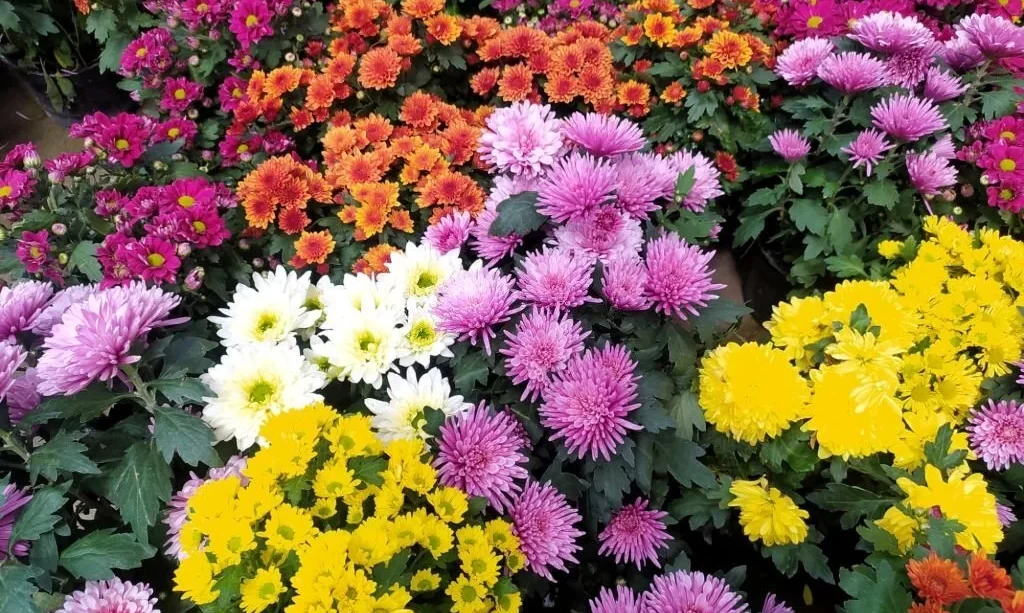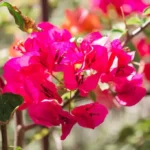Chrysanthemums, with their vibrant and intricate blooms, are a cherished presence in gardens and floral displays around the world. These colorful and diverse flowers, often simply referred to as “mums,” have earned a special place in the hearts of gardeners and flower enthusiasts alike. However, amid their popularity, questions often arise about their safety, particularly when it comes to their potential toxicity. In this exploration, we will unravel the complexities surrounding chrysanthemums, shedding light on their nature and addressing the common concern: Are chrysanthemums poisonous?
- FALL COLOR: Beautiful hardy mums that are sure to brighten up your Fall garden!
- GROWTH: Mums grow up to about 24″ tall with a spread of up to 24″.
- CARE: Chrysanthemums will bloom best in full sun. They thrive in well-draining soil and require even, consistent moisture.
- FUN FACT: Mums colors can symbolize different meanings, such as love, sorrow, well wishes, etc., making them a great gift for different occasions!
- LIVE PLANTS: Our plants are grown exclusively for Deep Roots and The Three Company, shipped fresh directly from our greenhouse to you!
Chrysanthemum Basics
Before delving into the question of chrysanthemum toxicity, it’s essential to establish a foundation of understanding about these captivating flowers.
A Palette of Diversity: Chrysanthemums belong to the genus Chrysanthemum and encompass a remarkable array of colors, shapes, and sizes. From the classic daisy-like forms to intricate, pom-pom-like blossoms, the diversity within the chrysanthemum family is a testament to the beauty that nature can offer. In gardens, they often grace us with their presence in late summer and fall, adding vibrant hues and textural variety to landscapes.
Cultural Significance: Chrysanthemums hold profound cultural significance in various parts of the world. In Japan, for example, they are regarded as a symbol of longevity and are celebrated during the Chrysanthemum Festival, or “Kiku no Sekku”. In other cultures, they are associated with joy and happiness, making them a popular choice for gifts and celebratory occasions.
As we embark on our journey to uncover the truth about chrysanthemums and potential toxicity concerns, understanding the fundamental nature and appeal of these flowers sets the stage for a comprehensive exploration of their safety for both humans and our furry companions.
Toxic Compounds in Chrysanthemums
To address concerns about chrysanthemum toxicity, it’s essential to explore the specific compounds within these flowers that can raise alarms.
Natural Insecticides: Chrysanthemums contain natural compounds known as pyrethrins and pyrethroids. These substances serve as the plant’s defense mechanisms against insect pests. Pyrethrins and pyrethroids are highly effective at paralyzing and killing insects by targeting their nervous systems.
Commercial Use: The insecticidal properties of pyrethrins and pyrethroids have not gone unnoticed by humans. These compounds have been harnessed for commercial use in various insect repellents and pesticides, particularly in products designed to control household pests like mosquitoes, flies, and roaches. Their potency against insects is well-documented and has led to their widespread adoption.
- FALL GIFT: Don’t miss the opportunity to give the gift of natural beauty to your loved one. This beautiful 4 pack of Fall mums is the perfect present for the plant lover in your life
- PLANT SIZE: Plants will arrive with a height of 12” – 15″ from bottom of the pot to top of the plant. Your hardy mums will continue to grow, sometimes reaching heights of 2 feet tall and 2 feet wide when cared for properly.
- PLANT FAMILY: Chrysanthemums are part of the Asteraceae family, they are related to the Aster, Daisy and Sunflower. The genus Chrysanthemum contains about 30 species of plants native to Asia and northeastern Europe.
- SHIP STAGE: In order for you to have the maximum experience with your fresh plants, all mums will be shipped with the color just starting to show on these healthy plants. They will arrive with lots of healthy buds ready to give more color throughout the entire season.
- LIVE PLANTS: Our plants are grown exclusively for Deep Roots and The Three Company, shipped fresh directly from our greenhouse to you!
Chrysanthemums and Human Health
While chrysanthemums contain compounds that can be toxic to insects, the impact on human health is quite different.
Limited Risk: Chrysanthemums, when admired or handled by humans in typical gardening or floral contexts, pose minimal risk. The concentration of pyrethrins and pyrethroids in chrysanthemum petals is generally too low to cause harm to humans. Simply touching or being near chrysanthemum flowers is unlikely to result in any adverse effects.
Sensitivities: It’s important to note that some individuals may be sensitive or allergic to chrysanthemums. Skin contact with the flowers or their pollen can occasionally lead to mild irritation or allergic reactions. However, these reactions are typically not severe and vary from person to person.
In summary, while chrysanthemums do contain natural compounds that have earned them a reputation as effective insecticides, the potential risks to human health from these compounds are generally limited. Responsible handling and enjoying these beautiful flowers in gardens and floral arrangements are unlikely to pose any significant health concerns for most individuals. It’s essential to maintain awareness of potential sensitivities while appreciating the vibrant beauty of chrysanthemums.
Chrysanthemums and Pets
When it comes to the safety of chrysanthemums, particularly in households with furry companions, considerations extend to our four-legged friends.
Pet Concerns: Chrysanthemums can pose a potential concern for pets, including cats and dogs, if ingested. The compounds found in chrysanthemums, specifically pyrethrins and pyrethroids, can lead to mild gastrointestinal upset in pets if they nibble on the leaves or flowers. Symptoms may include drooling, vomiting, or diarrhea.
Severity of Reactions: It’s important to emphasize that severe reactions or fatalities due to chrysanthemum ingestion in pets are exceedingly rare. However, as with any potential pet hazards, responsible pet ownership involves taking precautions to prevent access to chrysanthemum plants.
Safe Handling of Chrysanthemums
To ensure the safe enjoyment of chrysanthemums in gardens and floral arrangements, it’s prudent to follow some simple guidelines:
Wear Gloves: When handling chrysanthemums, especially if you have sensitive skin, wearing gloves can prevent skin irritation or allergic reactions. This precaution is particularly important for individuals who are known to have allergies to plants.
Handwashing: After handling chrysanthemums or working in areas where they are present, thorough handwashing with soap and water is advisable. This simple step can remove any residual pollen or plant material that might cause skin irritation.
Pet Protection: If you have pets, be mindful of where you place chrysanthemums or other potentially hazardous plants. Keep them out of reach of curious cats and dogs to prevent accidental ingestion.
- REAL PLANTS: Each order includes 1 bronze Chrysanthemum in 1 gallon pots for plants. Grow this live plant instead of fake mums for fall porch decor with seasonal garden decor and more. Enjoy plants for delivery prime – order today, unbox fast.
- LIVE FLOWERS: Instead of growing mum seeds, simply plant these mum plants in pumpkin-shaped planters for outdoor plants and relish the joy of fall outdoor decorations with ease. These fall plants deliver beautiful autumn colors all season long.
- OUTSIDE DECOR: Plant these decorative plants in mum planters to enhance your patio decor, balcony decor, or yard decor. These fall mums in 1 gallon pots for plants can elevate outdoor garden decor or an existing outdoor planter of perennial plants.
- GARDENING GIFTS: These outdoor plants are the perfect gifts for plant lovers. Give plant gifts as a housewarming gift or birthday present, or pair with potting soil and an outdoor plant stand for thoughtful gardening gifts for women you love.
- ABOUT PLANTS FOR PETS: Plants and animals make everything better, from simply raising our spirits to enriching our everyday lives. That’s why a portion of every purchase is directed to our mission to help place shelter animals in happy homes.
Conclusion
In conclusion, the question of whether chrysanthemums are poisonous requires nuanced consideration. While these flowers contain compounds that serve as natural insecticides and are used in commercial products for pest control, their impact on humans is generally minimal. Skin irritation or allergic reactions can occur in some individuals, but severe effects are rare.
When it comes to pets, chrysanthemums can lead to mild gastrointestinal upset if ingested. However, serious pet poisoning cases involving chrysanthemums are uncommon. Responsible pet ownership involves keeping potentially harmful plants out of reach.
In the grand tapestry of gardening and floral enjoyment, chrysanthemums continue to hold their place as vibrant and cherished contributors. By understanding the nuances of their potential risks and taking appropriate precautions, we can ensure that the beauty of these blooms remains a safe and delightful part of our lives, both indoors and in our gardens.






